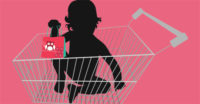Culture at the Core of Design
Brands with a meaningful connection to consumers promote an ideology that’s both distinctive and shared.


Though adding a lime wedge to a Corona has become standard practice among consumers, how that got started remains uncertain.

Monster Jam packaging



Culturally relevant brands are rare and cut from different cloth than 99 percent of all existing brands. They become iconic because they are transcendent and deeply meaningful to people’s lives. Many marketers mistakenly believe that these brands are simply highly emotive and experiential, but they actually go well beyond that.
Culturally relevant brands seemed to evolve in the past without strategic planning. Disney, Harley-Davidson, Budweiser, Barbie, LEGO, Levi’s and McDonald’s are a few brands that have achieved cultural icon status. Some of them have experienced turbulence and floundered before coming back strongly, while others are currently experiencing strong headwinds. Whether they can continue to adapt as their core constituencies evolve remains to be seen. But let’s remember that some brands that had cultural relevance in the past and then faded have made spectacular comebacks, as well. Hasbro’s Transformers and ITV Studios’ Thunderbirds Are Go are strong examples of quasi consumer brands/entertainment properties that are culturally relevant and arguably more powerful now than they were in their first iterations thanks to visionary brand stewardship and mixed media exposure.
Culturally relevant brands have three distinct features: lifestyle, beliefs and the shared value systems of a group. They remain relevant if they recall their heritage (or something significant from our shared cultural heritage if they’re new brands), while continually adapting to and changing with their fans’ evolving lives. Brands that are successful in doing this become iconic.
why aim for cultural relevance?
In today’s sophisticated society, there is impetus to deliberately design brands in this manner because cultural relevancy is the ultimate brand differentiator. In his book, “How Brands Become Icons: The Power of Cultural Branding,” Douglas Holt, associate professor of marketing at the Harvard Business School, makes the case that most brand marketers’ interests lie in functional product innovations. This interest makes it very difficult for their brands to decisively win their categories since much of the competition is doing the same thing. He argues that the most successful brands own their categories because of what they stand for and symbolize—not for what their products offer—making them cultural icons. As a result, consumers who love these brands perceive that the desirability and the quality of their products are superior to everything else in the marketplace.¹
To be culturally relevant, a brand must have a unique, ideologically-driven world view. A myth or story has to be crafted with traits from a distinctive personality or archetype that will have direct appeal to a specific group of consumers. The myth and its ideology must be framed within cultural context and filled with relevant cues. Symbols must be employed using verbal and visual expressions that are universally understood by our culture—and enthusiastically embraced and lived by a specific group within it. The fans of a cultural brand will then mold and fit the brand into their lives in a highly individualistic manner while retaining the ethos of the core brand.
Culturally relevant brands are created now by design. Each visual and verbal design element symbolizing these brands is crafted with specific cultural references. These elements are then brought together in a unique, one-of-a-kind manner.
measuring cultural relevance
Cultural brands appeal to very large consumer groups as well as smaller, targeted consumer groups. There are a few behemoths that own huge mind-share with many consumer groups across social strata and around the globe. Among entertainment properties, Star Wars and the pantheons of Disney princesses and Marvel superheroes are great examples of this. While other well-known properties don’t enjoy such broad-based audiences, it doesn’t mean that they don’t have immense relevance for their fans. For example, PAW Patrol has great meaning for the pre-school set. Monster Jam and NASCAR appeal strongly to thrill seekers of motorsports who revel in the power and the roar of engines (but not necessarily the same fans because these brands are based on two very different myths). The NFL is high on the list of sports aficionados who enjoy the athleticism and strategies involved in football played at its highest level.
There is a direct correlation between cultural relevance and brand value. Because its fans use a culturally-based brand to self-identify, it becomes an indispensable part of their lives. They also enjoy a powerful sense of belonging within a special community of shared values. This is the reason why we refer to the fans of these brands as a cult or a tribe.
Inherent in culturally relevant brands are specific rituals that likewise reinforce their value. For example, Corona beer’s persona is built around a relaxed, beach lifestyle and a flavorful brew, inspiring a cult of fans far and wide. Deep within our hardworking, multitasking culture exists a powerful yearning to sit on a beach and enjoy the company of friends with a few beers. In fact, this is a summer ritual for many people. Corona adds another layer of ritual: The act of pushing a wedge of lime into a Corona beer bottle is so pervasive that it is central to the brand and practiced by its fans without question.
Rather than marketing its brand based on quality and taste innovations like so many competitors in the beer category, and settling for a sliver of market share, Corona built a brand with cultural appeal based upon a specific point of view and story—aimed at a targeted group of consumers—and vaulted above competing brands as a result. Corona Extra is ranked first in the United States among imported beers,² and it was ranked fifth in overall beer sales in the United States in 2015. This demonstrates the power of culturally relevant branding.
When packaging extends and reinforces the unique cultural aspects of a brand, there’s an immediate impact. Every memory, every shared experience and every bit of the enjoyment associated with the brand is relived and savored in a deeply personal manner; it all becomes embedded in its fans’ lives. For brands, it doesn’t get any better than this and it’s all based on a deliberately conceived, bold design.
¹ http://douglasholt.org/wp-content/uploads/2012/01/Cultural-Brand-Strategy.pdf
² http://www.statista.com/statistics/188728/top-imported-beer-brands-in-the-united-states/
³ http://www.tbo.com/news/breaking-news/americas-monster-jam-has-gone- international-20141205/
⁴ http://talkingpointsmemo.com/theslice/what-i-learned-about-america-at-a-las-vegas-monster-truck-show
monster jam: a case study in culturally relevant branding
To say that there is a car culture in America is an understatement. Even then, FELD Entertainment’s Monster Jam brand represents a unique cultural phenomenon. Four million people attend 350 Monster Jam events annually, and one third of attendees are kids aged 12 and under—so it’s obvious that the brand appeals to entire families. Fans are delighted by 12-foot-high monster trucks with 66-inch tires that still have the dexterity to leap into the air and come down crushing old cars in a spectacular manner. Monster Jam trucks symbolize America: bigger, bolder, stronger and more audacious—which has great appeal to a slice of the middle class in this country.
Not only do fans in America respond to the thrill of a Monster Jam event, fans in other countries respond to this culture-centric brand since its international expansion in 2012. Nigel Morris, a retired UK-based driver of Monster truck Bigfoot #17 was quoted in an interview, “The things that people love about monster trucks in America are the things they love in other countries. It’s a dramatic show. Lots of action. Lots of horsepower.”³ FELD Entertainment CEO, Kenneth Feld, who is now worth a cool $1.8 billion, told the Associated Press, “We’re monster trucking the world.” But that didn’t just happen without achieving cultural relevance, and brand design was the catalyst behind this success.
The Monster Jam brand continuously evolves to remain relevant. Driver Tom Meents spoke of this in a recent article, “In the beginning, they [monster trucks] were like steamrollers. Now they are more [like] jet fighters.”⁴ Because of design improvements, monster trucks can perform jumps, turns and flips that defy gravity in spite of their size. An effort has been made to appeal to young fans, as well. Monster trucks sporting canine features with names like Scooby Doo, Monster Mutt Dalmation and Monster Mutt Rottweiler appeal to the kids who throng arenas dressed as their favorites and play with Hot Wheels miniatures of them. Adults show off tattoos of their favorite vehicles and don Monster Jam t-shirts and gear.
Fans are invited into many arenas before the events begin in a fabled “Party in the Pits” where they mingle easily with their favorite drivers who sign autographs and pose for pictures. Acquaintances are renewed with other fans and friendships are formed at these parties. Monster Jam inspires a cult-like following filled with rabid fans who just can’t get enough of their favorite brand thanks to smart licensing agreements, strong brand packaging and events that engage and excite.
Delivering the Monster Jam brand via packaging
When extending the cultural relevance of brands via packaging, we at Design Force look beyond the competitors within their categories because we aren’t interested in staying within those confines or in emulating a “category look.” Rather the opposite. We want to break out of the pack, focusing on leveraging the mythology of the brand and incorporating powerful cues based on its unique culture. Working closely with the marketing group at FELD Entertainment, we designed the licensed product packaging program for the brand in the past and recently updated it for 2016. When refreshing a brand we retain the most equitable visual and verbal assets and update them so that the package design system speaks to legions of fans and their evolving relationship with that brand. There are other monster truck brands across the country, so it is important for us to ensure that Monster Jam continues to dominate the category.
Monster Jam arena-based events packed with fans represent an exciting, unique form of entertainment. All of the cultural cues that embody the Monster Jam brand have been captured on licensed consumer product packaging to make an impact. The entire background of the package design is covered with an image of dirt from the arena floor traversed by deep tracks made by the iconic Monster Jam tire treads. Package design architecture trims the dirt background with an angled metal framework in deep blue and chrome. We leveraged a monochromatic blue image of an arena interior, as a backdrop to product photography and as a window box insert, to place fans in the center of the action. Monster Jam vehicle product photography or illustration is depicted leaping through the air toward the consumer, with crushed cars beneath it. Product benefits and features are contained within riveted metal violators and the product name appears in a yellow, distressed font on a brushed metal plate. All of the grit, power and excitement embodied by the Monster Jam brand are part of the package design system.
Looking for a reprint of this article?
From high-res PDFs to custom plaques, order your copy today!









